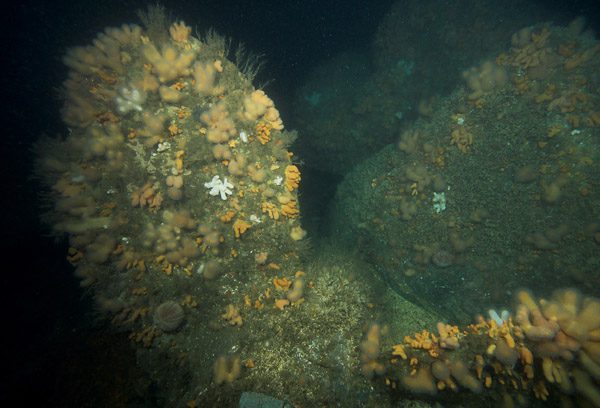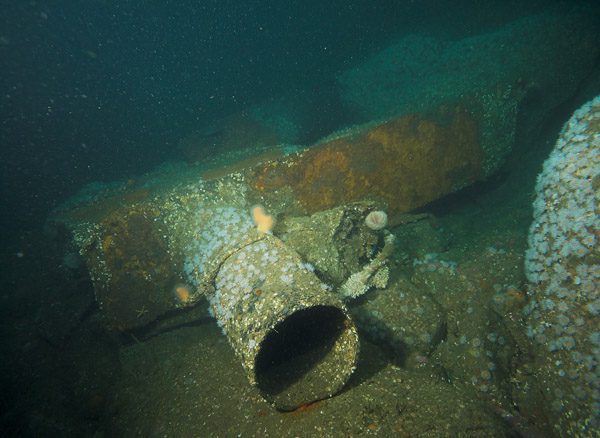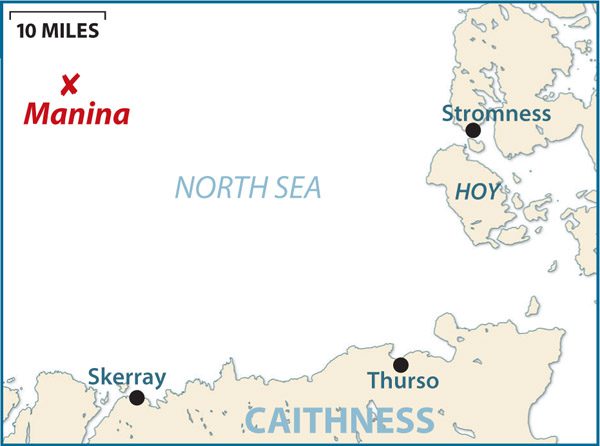We visit a more recent but rarely dived wreck this month, a cargo vessel lost off the Orkneys during bad weather with the loss of nine crew. JOHN LIDDIARD leads the way, illustration by MAX ELLIS
WRECKED ON SULE STACK on 8 April, 1968, and first dived on 28 May 1997, the 1333-ton motor ship Manina is still visited only a handful of times a year at most.
While the existence of the wreck has long been known, the first to dive it were Stromness-based wreck-researcher Kevin Heath and Malcolm Daughtrey from East Cheshire BSAC.
The club were regular visitors to Scapa Flow, fancied a bit of exploration and invited Kevin to join them for the day.
Diving from mv Triton, an echo was found in 40m, a shot dropped and Kevin and Malcolm were the first in to see if they had found the wreck.
The helm of the Manina was subsequently raised and restored, and can now be seen at Scapa Scuba in Stromness.
When I dived the wreck, Andy Cuthbertson, skipper of Jean Elaine, had been waiting for a few days of calm sea. He wanted to allow plenty of time for the groundswell to die down to a manageable level before venturing the 40 miles from Stromness. Wisely, he wouldn’t risk going that far only to find it too rough to dive.
A shotline is no longer needed, because there is a trail of wreckage all the way back to the cleft in the middle of Sule Stack.
Dives on the Manina now conveniently begin dropped in close to the rocks before swimming to the cleft to descend (1), dropping through the surge to the first identifiable piece of wreckage, which is the rudder (2).
Following the slope down, as the cleft widens the next identifiable parts of the wreckage are from the engine and refrigeration machinery (3) and (4).
The wreck continues as sporadic debris until 32m, where a section of derrick runs to a sizeable section of keel (5).
As the keel section ends, with only the propeller-shaft protruding, an anchor (6) can be found lying on top of a rock off to the north side of the keel at 36m.
Returning to the propshaft, it continues a few metres deeper to the propeller (7), at a depth of 40m.
Our route now turns south past scattered hull-plates (8) and along the face of a rock with a section of railing propped against it (9).

Crossing a low ridge, wreckage continues with some sections of derrick (10) and then a more bulky section of mast with a T across it (11).
Across the next ridge brings us to the vicinity of the bow, as evidenced by anchor chain (12) leading from a hole in what would have been the bow deck, still threaded through the tube of a hawse-pipe to a more recognisable section of the bow (13).
Only a few metres further south, the scattered plates fizzle out at 42m (14).
Turning back past the anchor-chain, a parallel pair of beams may have been a goal-post mast (15). These point up the slope to a more obvious rounded section of mast (16), within sight of the rocky wall of the stack.

The base of this mast is close to another ridge protruding from the wall, and scattered debris continues around this ridge, past a pair of bollards (17) and a section of piston (18), which completes a circuit back to the cleft where we started.
Ascending the wall slightly, a narrow ledge (19) runs along at 14m, with scraps of wreckage among the kelp, descending slightly to 18m and a cargo-winch (20).
Considering that this is almost directly above the bow, it may also have served as the anchor-winch.
At a location this remote, divers should not take any chances with decompression, and as much additional safety-stop time as you have gas for can easily be made while ascending the shallower section of the wall (21).
Although covered in kelp, in among the roots is a dense packing of anemones. For many divers, this would make an excellent shallow scenic dive by itself, so it comes as a bonus after the deeper wreck.
TRAGEDY IN THE 1960S
THE MANINA, cargo vessel. BUILT 1947, SUNK 1968
THE 1333-TON MOTOR SHIP Manina was built in 1947 by Eriksberg Mekaniske Verkstad A/B – Eriksberg Varv of Gothenburg as the Norwegian-flagged Corvus.
The Greek company Kanav Shipping later changed the name to Manina.
On 8 April, 1968, the Manina was in ballast from Bergen to Glasgow, under the command of Captain Victor Kapsokefalos. A westerly force 7 wind was causing a short and steep sea.
It might have been a strong wind, but it should not have troubled a ship of this size. Nevertheless, the Manina ran into Sule Stack.
Flares were fired and spotted by the lighthouse-keepers on Sule Skerry, 10 miles to the north. Two lifeboats from Orkney and one from Stromness were launched and an RAF Shackleton reconnaissance aircraft directed overhead, soon to be replaced by another when the first Shackleton developed engine problems.
By the time the lifeboats arrived, there was no sign of any survivors on the rock or nearby.
The Manina had completely broken up, leaving only a slick of engine oil and scattered floating debris.
Several other vessels in the area also headed to the rescue. The Swedish tanker Vassajaure picked up five of the crew, including second mate Vassilias Kyriacou, from a lifeboat.
The remainder of the 14 crew, including Captain Kapsokefalos, were lost, with five of the bodies being picked up by the Vassajaure or transferred from other vessels.
The Vassajaure headed on towards the Outer Hebrides, transferring the survivors and bodies to the Stornoway lifeboat to be landed on Lewis.
The Stromness lifeboat returned home with a further two bodies recovered from the sea.
Tour Guide
GETTING THERE: Northlink operates ferry services from Scrabster to Stromness and Aberdeen to Kirkwall, 0845 6000 449.
HOW TO FIND IT: GPS co-ordinates are 59 01.401, N 004 30.434W (degreees, minutes and decimals). The Manina lies on the south-east side of Sule Stack and is easy enough to find by entering the water by the cleft in the stack and following the valley of debris down.
TIDES: The Manina can be dived at any state of the tide, but a few days of calm weather is advised before venturing there.
DIVING & AIR: Take one of the large Scapa Flow charter-boats out for the day. Scapa Flow Charters operates Jean Elaine and Sharon Rose, 01856 850879.
ACCOMMODATION: Sleep on the boat, or stay ashore in a local hotel or B&B. There is a campsite in Stromness, but camping in the Orkney climate is not advisable. Orkney Tourist Board, 01856 872856.
LAUNCHING The most convenient slip is in the harbour at Skerray on the mainland.
QUALIFICATIONS: It’s not a difficult dive but there can be a lot of swell, so it’s not recommended for beginners.
FURTHER INFORMATION: Admiralty Chart 1954, Cape Wrath to Pentland Firth. Ordnance Survey Map 10, Strathnaver. Ordnance Survey Map 6, Orkney – Mainland, and Map 7 Orkney – Southern Isles. The Wrecks of Scapa Flow, by Lawson Wood.
PROS: Something off the beaten track with depth variation to suit most divers.
CONS: Exposed crossing from Orkney or the mainland.
DEPTH: 20m – 35m, 35m – 45m
Thanks to Andy Cuthbertson, Kevin Heath, and various divers from Swansea and Leeds.
Appeared in DIVER January 2013



